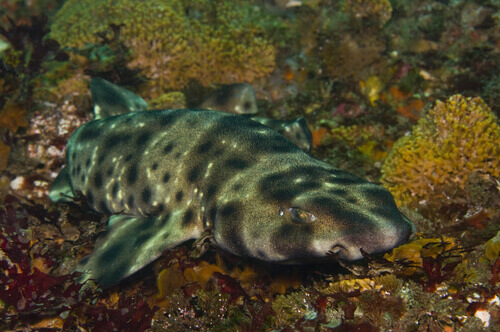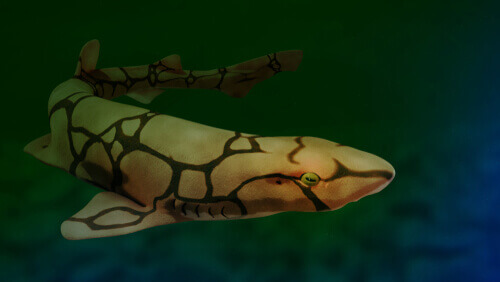The Secret of Glow-in-the-Dark Sharks

Bioluminescence, the secret of glow-in-the-dark sharks, is a common phenomenon in marine species. It’s a defense strategy mainly. Relatively recent findings indicate there are deep-sea sharks that emit bright green light through their skin. This quality doesn’t seem too useful when someone wants to remain anonymous. However, there are many advantages to it. Continue reading to find out more about these mysterious animals who glow in the dark.
Glow-in-the-dark sharks
There are many bioluminescent animals. In some of them, this is due to green fluorescent proteins called GFP, as in jellyfish and crustaceans. It may also be indirectly due to symbiosis with luminescent bacteria, as is the case of the squid Euprymna scolopes.
In 2019, a group of researchers discovered some sharks that could communicate with each other through fluorescence. They were the Cephaloscyllium ventriosum (Catshark) and Scyliorhinus retifer (the Chain dogfish) species, which belong to the same family and whose skin has both light and dark tones.
There’s an established metabolic route of Bromo-tryptophan-kynurenine molecules in these beings. This is the reason for their bioluminescence.

The catshark
In addition to the light and dark tones on the skin of this species, they have fluorescent green spots all over their body.
The chain dogfish shark
Unlike the catshark, this species doesn’t have fluorescent dots as a characteristic. Instead, the skin has a pattern of linked black lines with dark and light areas.
Advantages of a glow-in-the-dark shark
According to a study published in the journal Science Daily, researchers used fluorescence microscopy to examine tissue samples from the skin of these sharks. They noticed the fluorescence only in lighter skin and that it shone differently in each species.
Another interesting finding was that these sharks have a special ability to see the bioluminescence. This is because their visual mechanism allows them to detect it. This is an advantage because, although they’re not visible to other fish, they can definitely communicate with one another.
In addition, each species emits the light it produces in a specific way.
Thus, bioluminescence allows individuals of the same species to communicate and also helps them hide from their predators.
Metabolites have antibacterial properties
Catsharks spend their lives circulating across the seabed (they’re benthic) and moving sinuously through the sediments of the depths. Marine bacteria such as Staphylococcus aureus and Vibrio parahaemolyticus reside in these areas.
This inspired the aforementioned researchers to put the bioluminescence-producing metabolites to the test. This is because they wanted to see how they acted against bacteria.
What they found is these small molecules protect animals from microbial attacks. This makes sense because these glow-in-the-dark sharks are in constant contact with the seabed.
Another property of metabolites
In recent years, studies focused on bioluminescence have been a great step in scientific advancement. We’re still really far from understanding how it works, despite the large number of publications explaining aspects of how and why it occurs.
In addition to the data obtained in the research mentioned above, there’s another interesting discovery. It’s a parallelism between the biosynthetic pathway of the Bromo-kynurenine of metabolites and the tryptophan-kynurenine pathway that occurs in vertebrates.
The latter regulates various biological processes in humans. For example, the accumulation of kynurenine in the brain related to mental disorders such as depression and schizophrenia. Therefore, these metabolites could play an important role in the human central nervous system.

Glow-in-the-dark sharks, a world of light
After these findings, we can say that the bioluminescence generated in these sharks has unique properties.
In this case, their metabolites are destined to emit a bright green color throughout the light areas of the skin. Thanks to this quality, these species are invisible to other marine creatures and can still detect each other.
Likewise, these same molecules offer them resistance to bacterial infections. After everything we’ve mentioned here about these glow-in-the-dark sharks, we can only say that nature never ceases to amaze us.
All cited sources were thoroughly reviewed by our team to ensure their quality, reliability, currency, and validity. The bibliography of this article was considered reliable and of academic or scientific accuracy.
- Park, H.B. et al. Bright green biofluorescence in sharks derives from Bromo-Kynurenine metabolism. iScience (2019) 19: 1277-1286.
- https://biogeodb.stri.si.edu/caribbean/es/thefishes/species/2681
- https://cienciaybiologia.com/tiburones-verde-fluorescente/
- https://www.nationalgeographic.com.es/naturaleza/estos-tiburones-brillan-oscuridad_14614/3
